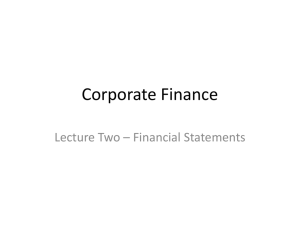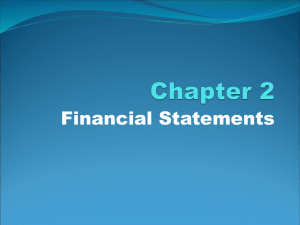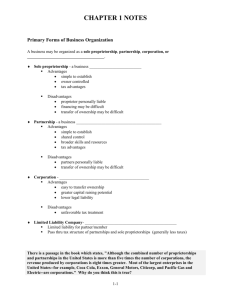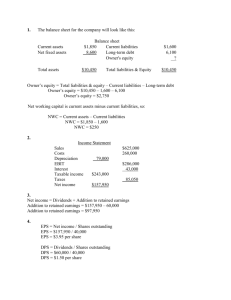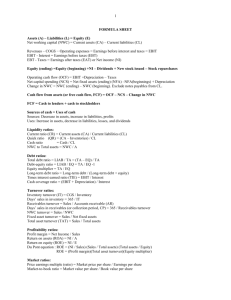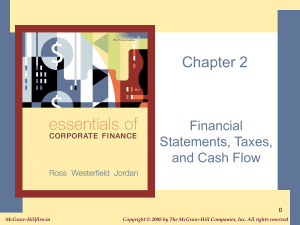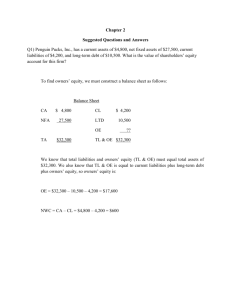Financial Statements, Taxes & Cash Flows Solutions
advertisement
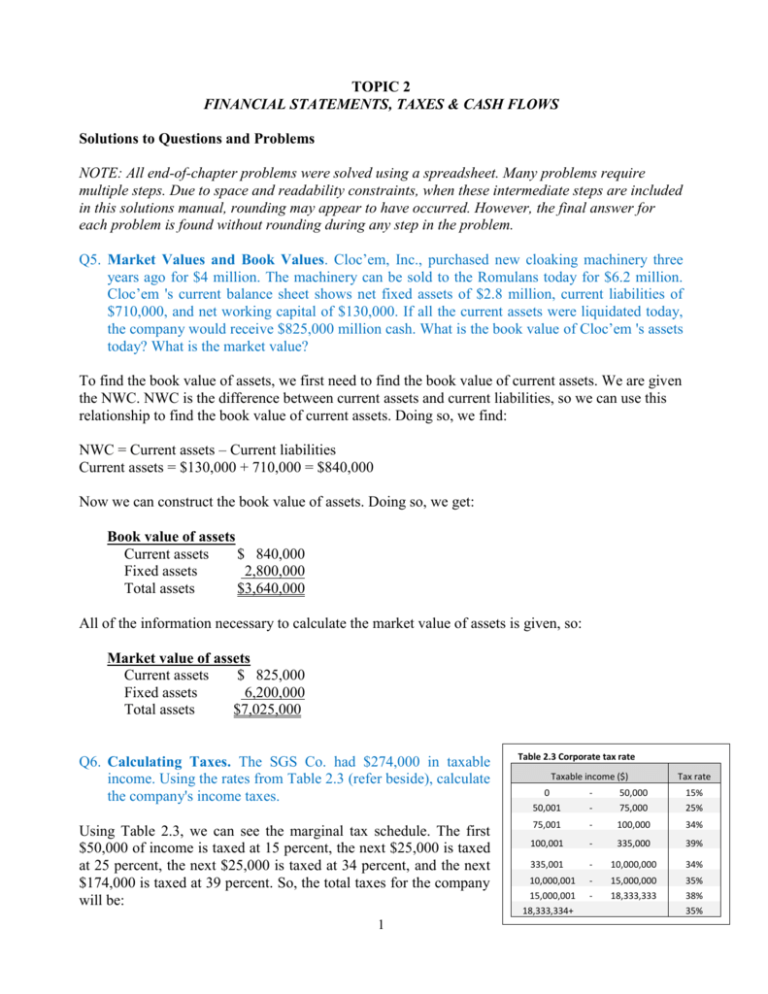
TOPIC 2 FINANCIAL STATEMENTS, TAXES & CASH FLOWS Solutions to Questions and Problems NOTE: All end-of-chapter problems were solved using a spreadsheet. Many problems require multiple steps. Due to space and readability constraints, when these intermediate steps are included in this solutions manual, rounding may appear to have occurred. However, the final answer for each problem is found without rounding during any step in the problem. Q5. Market Values and Book Values. Cloc’em, Inc., purchased new cloaking machinery three years ago for $4 million. The machinery can be sold to the Romulans today for $6.2 million. Cloc’em 's current balance sheet shows net fixed assets of $2.8 million, current liabilities of $710,000, and net working capital of $130,000. If all the current assets were liquidated today, the company would receive $825,000 million cash. What is the book value of Cloc’em 's assets today? What is the market value? To find the book value of assets, we first need to find the book value of current assets. We are given the NWC. NWC is the difference between current assets and current liabilities, so we can use this relationship to find the book value of current assets. Doing so, we find: NWC = Current assets – Current liabilities Current assets = $130,000 + 710,000 = $840,000 Now we can construct the book value of assets. Doing so, we get: Book value of assets Current assets $ 840,000 Fixed assets 2,800,000 Total assets $3,640,000 All of the information necessary to calculate the market value of assets is given, so: Market value of assets Current assets $ 825,000 Fixed assets 6,200,000 Total assets $7,025,000 Q6. Calculating Taxes. The SGS Co. had $274,000 in taxable income. Using the rates from Table 2.3 (refer beside), calculate the company's income taxes. Using Table 2.3, we can see the marginal tax schedule. The first $50,000 of income is taxed at 15 percent, the next $25,000 is taxed at 25 percent, the next $25,000 is taxed at 34 percent, and the next $174,000 is taxed at 39 percent. So, the total taxes for the company will be: 1 Table 2.3 Corporate tax rate Taxable income ($) Tax rate 0 50,001 - 50,000 75,000 15% 25% 75,001 - 100,000 34% 100,001 - 335,000 39% 335,001 - 10,000,000 34% 10,000,001 15,000,001 18,333,334+ - 15,000,000 18,333,333 35% 38% 35% Taxes = 0.15($50,000) + 0.25($25,000) + 0.34($25,000) + 0.39($274,000 – 100,000) Taxes = $90,110 Q14.Calculating Total Cash Flows. Sheffield Co. shows the following information on its 2010 income statement: sales = $153,000; costs = $81,900; other expenses = $5,200; depreciation expense = $10,900; interest expense = $8,400; taxes = $16,330; dividends = $7,200. In addition, you're told that the firm issued $2,600 in new equity during 2010, and redeemed $3,900 in outstanding long-term debt. a. What is the 2010 operating cash flow? b. What is the 2010 cash flow to creditors? c. What is the 2010 cash flow to stockholders? d. If net fixed assets increased by $19,475 during the year, what was the addition to NWC? a. To calculate the OCF, we first need to construct an income statement. The income statement starts with revenues and subtracts costs to arrive at EBIT. We then subtract out interest to get taxable income, and then subtract taxes to arrive at net income. Doing so, we get: Income Statement Sales $153,000 Costs 81,900 Other Expenses 5,200 Depreciation 10,900 EBIT $55,000 Interest 8,400 Taxable income $46,600 Taxes 16,330 Net income $30,270 Dividends Addition to retained earnings $7,200 23,070 Dividends paid plus addition to retained earnings must equal net income, so: Net income = Dividends + Addition to retained earnings Addition to retained earnings = $30,270 – 7,200 Addition to retained earnings = $23,070 So, the operating cash flow is: OCF = EBIT + Depreciation – Taxes OCF = $55,000 + 10,900 – 16,330 OCF = $49,570 b. The cash flow to creditors is the interest paid, minus any new borrowing. Since the company redeemed long-term debt, the net new borrowing is negative. So, the cash flow to creditors is: 2 Cash flow to creditors = Interest paid – Net new borrowing Cash flow to creditors = $8,400 – (–$3,900) Cash flow to creditors = $12,300 c. The cash flow to stockholders is the dividends paid minus any new equity. So, the cash flow to stockholders is: Cash flow to stockholders = Dividends paid – Net new equity Cash flow to stockholders = $7,200 – 2,600 Cash flow to stockholders = $4,600 d. In this case, to find the addition to NWC, we need to find the cash flow from assets. We can then use the cash flow from assets equation to find the change in NWC. We know that cash flow from assets is equal to cash flow to creditors plus cash flow to stockholders. So, cash flow from assets is: Cash flow from assets = Cash flow to creditors + Cash flow to stockholders Cash flow from assets = $12,300 + 4,600 Cash flow from assets = $16,900 Net capital spending is equal to depreciation plus the increase in fixed assets, so: Net capital spending = Depreciation + Increase in fixed assets Net capital spending = $10,900 + 19,475 Net capital spending = $30,375 Now we can use the cash flow from assets equation to find the change in NWC. Doing so, we find: Cash flow from assets = OCF – Change in NWC – Net capital spending $16,900 = $49,570 – Change in NWC – $30,375 Change in NWC = $2,295 Q15. Using Income Statements. Given the following information for Sookie’s Cookies Co., calculate the depreciation expense: sales = $51,000; costs = $39,800; addition to retained earnings = $2,300; dividends paid = $925; interest expense = $1,230; tax rate = 40 percent Here we need to work the income statement backward. Starting with net income, we know that net income is: Net income = Dividends + Addition to retained earnings Net income = $925 + 2,300 Net income = $3,225 Net income is also the taxable income, minus the taxable income times the tax rate, or: Net income = Taxable income – (Taxable income)(Tax rate) Net income = Taxable income (1 – Tax rate) 3 We can rearrange this equation and solve for the taxable income as: Taxable income = Net income / (1 – Tax rate) Taxable income = $3,225 / (1 – .40) Taxable income = $5,375 EBIT minus interest equals taxable income, so rearranging this relationship, we find: EBIT = Taxable income + Interest EBIT = $5,375 + 1,230 EBIT = $6,605 Now that we have the EBIT, we know that sales minus costs minus depreciation equals EBIT. Solving this equation for EBIT, we find: EBIT = Sales – Costs – Depreciation $6,605 = $51,000 – 39,800 – Depreciation Depreciation = $4,595 Q16. Preparing a Balance Sheet: Prepare a balance sheet for Maskara Ltd. as of December 31, 2010, based on the following information: cash = $193,000; patents and copyrights = $847,000; accounts payable = $296,000; accounts receivable = $253,000; tangible net fixed assets = $5,100,000; inventory = $538,000; notes payable = $189,000; accumulated retained earnings = $4,586,000; long-term debt = $1,250,000. We can fill in the balance sheet with the numbers we are given. The balance sheet will be: Balance Sheet Cash Accounts receivable Inventory Current assets $193,000 253,000 538,000 $984,000 Accounts payable $296,000 Notes payable 189,000 Current liabilities $485,000 Long-term debt 1,250,000 Total liabilities $1,735,000 Shareholders’ funds Common stock ?? Accumulated retained earnings 4,586,000 Total liabilities & owners’ equity$6,931,000 Tangible net fixed assets $5,100,000 Intangible net fixed assets 847,000 Total assets $6,931,000 Owners’ equity has to be total liabilities & equity minus accumulated retained earnings and total liabilities, so: Owner’s equity = Total liabilities & equity – Accumulated retained earnings – liabilities Owners’ equity = $6,931,000 – 4,586,000 – 1,735,000 Owners’ equity = $610,000 4 Total

